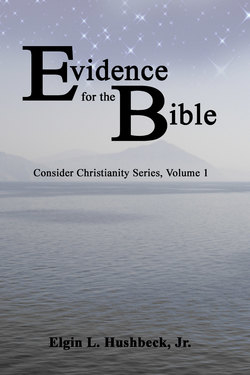Читать книгу Evidence for the Bible - Elgin L Hushbeck Jr. - Страница 13
На сайте Литреса книга снята с продажи.
The Canon of the New Testament
ОглавлениеWhen we come to the New Testament, once again the evidence for the canon is even greater than that for the Old Testament. By the time of Peter’s death, which occurred no later than A.D. 68,g some of the writings of the apostles were already being accepted as Scripture. This can be seen in the second letter written by Peter when he states:
Bear in mind that our Lord’s patience means salvation, just as our dear brother Paul also wrote you with the wisdom that God gave him. He writes the same way in all his letters, speaking in them of these matters. His letters contain some things that are hard to understand, which ignorant and unstable people distort, as they do the other Scriptures, to their own destruction. (2 Peter 3:15-16)
Here Peter clearly sees the writings of Paul on an equal footing with the “other Scriptures.” The apostle Paul, writing at about the same time, refers to a passage in the Gospel of Luke as Scripture.h
Through the writings of the church fathers during the first 300 years of church history, one can trace the development of the canon. Most of the books were accepted very early and were not seriously questioned afterward. By the end of the first century, the letters of Paul were being collected. Around A.D. 160 the four Gospels were combined into a single unit called the Diatessaron.
Much of the push to establish a canon came about as a reaction to Marcion, a wealthy ship-owner who moved to Rome in A.D. 140 and joined the Christian community there. Marcion was extremely anti-Semitic and rejected anything Jewish. Around A.D. 140, he decided to produce his own version of the canon. He threw out the entire Old Testament, along with three of the four Gospels. The Gospel of Luke was acceptable to him, but only after it had been ”cleaned up” to remove all references to Judaism.
Marcion’s version of the canon was clearly unacceptable and self-serving, but it raised the question: If his canon was wrong, which books made up the true canon? A manuscript from about A.D. 170-180 gives us a description of the canon as it was then beginning to take shape. Called the Muratorian Canon, after its discoverer, Lodovica Muratori, the manuscript contains a description of the books that were considered to be Scripture. The list is very close to the books we find in the New Testament today. The books of Hebrews, 1&2 Peter, and 3 John were not mentioned. The Revelation of Peter is noted as questionable, while The Shepherd of Hermas was rejected.15
The discussion within the church concerning the contents of the canon continued. While the majority of the books were accepted, a few books were still being discussed. Around the year A.D. 300, Eusebius compiled a list of books that were under consideration at that time. He divided the books into three categories. In the category of Homologoumena — those books accepted by all — he placed most of the books that are in the New Testament (the four Gospels, Acts, the letters of Paul, 1 Peter, 1 John, and the book of Revelation). The remaining books of the New Testament, Eusebius placed in the category of amphiballomena — books disputed by some but “recognized by most churchmen.”16 All other books that had at one time been considered but that do not appear in the New Testament, Eusebius placed in the category of notha — spurious writings. By the time of the council of Carthage in A.D. 397, the Western church had reached enough of a consensus over the form of the canon to approve a list of books identical to that used today.
